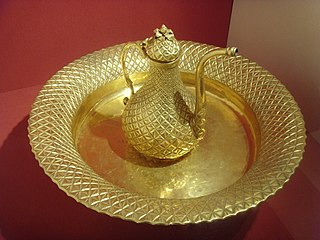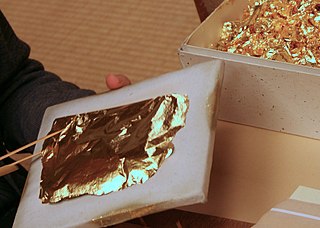
An alloy is an admixture of metals, or a metal combined with one or more other elements. For example, combining the metallic elements gold and copper produces red gold, gold and silver becomes white gold, and silver combined with copper produces sterling silver. Combining iron with non-metallic carbon or silicon produces alloys called steel or silicon steel. The resulting mixture forms a substance with properties that often differ from those of the pure metals, such as increased strength or hardness. Unlike other substances that may contain metallic bases but do not behave as metals, such as aluminium oxide (sapphire), beryllium aluminium silicate (emerald) or sodium chloride (salt), an alloy will retain all the properties of a metal in the resulting material, such as electrical conductivity, ductility, opacity, and luster. Alloys are used in a wide variety of applications, from the steel alloys, used in everything from buildings to automobiles to surgical tools, to exotic titanium alloys used in the aerospace industry, to beryllium-copper alloys for non-sparking tools. In some cases, a combination of metals may reduce the overall cost of the material while preserving important properties. In other cases, the combination of metals imparts synergistic properties to the constituent metal elements such as corrosion resistance or mechanical strength. Examples of alloys are steel, solder, brass, pewter, duralumin, bronze, and amalgams.

Gold is a chemical element with the symbol Au and atomic number 79, making it one of the higher atomic number elements that occur naturally. In a pure form, it is a bright, slightly reddish yellow, dense, soft, malleable, and ductile metal. Chemically, gold is a transition metal and a group 11 element. It is one of the least reactive chemical elements and is solid under standard conditions. Gold often occurs in free elemental (native) form, as nuggets or grains, in rocks, in veins, and in alluvial deposits. It occurs in a solid solution series with the native element silver, naturally alloyed with other metals like copper and palladium and also as mineral inclusions such as within pyrite. Less commonly, it occurs in minerals as gold compounds, often with tellurium.

A metal is a material that, when freshly prepared, polished, or fractured, shows a lustrous appearance, and conducts electricity and heat relatively well. Metals are typically malleable or ductile. A metal may be a chemical element such as iron; an alloy such as stainless steel; or a molecular compound such as polymeric sulfur nitride.

Metallurgy is a domain of materials science and engineering that studies the physical and chemical behavior of metallic elements, their inter-metallic compounds, and their mixtures, which are known as alloys. Metallurgy encompasses both the science and the technology of metals; that is, the way in which science is applied to the production of metals, and the engineering of metal components used in products for both consumers and manufacturers. Metallurgy is distinct from the craft of metalworking. Metalworking relies on metallurgy in a similar manner to how medicine relies on medical science for technical advancement. A specialist practitioner of metallurgy is known as a metallurgist.

Solder is a fusible metal alloy used to create a permanent bond between metal workpieces. Solder is melted in order to adhere to and connect the pieces after cooling, which requires that an alloy suitable for use as solder have a lower melting point than the pieces being joined. The solder should also be resistant to oxidative and corrosive effects that would degrade the joint over time. Solder used in making electrical connections also needs to have favorable electrical characteristics.
Cymbals are made from four main alloys, all of them copper-based. These are: bell bronze, malleable bronze, brass, and nickel silver.

Orichalcum or aurichalcum is a metal mentioned in several ancient writings, including the story of Atlantis in the Critias of Plato. Within the dialogue, Critias claims that orichalcum had been considered second only to gold in value and had been found and mined in many parts of Atlantis in ancient times, but that by Critias's own time orichalcum was known only by name.

Gilding is a decorative technique for applying a very thin coating of gold to solid surfaces such as metal, wood, porcelain, or stone. A gilded object is also described as "gilt". Where metal is gilded, the metal below was traditionally silver in the West, to make silver-gilt objects, but gilt-bronze is commonly used in China, and also called ormolu if it is Western. Methods of gilding include hand application and gluing, typically of gold leaf, chemical gilding, and electroplating, the last also called gold plating. Parcel-gilt objects are only gilded over part of their surfaces. This may mean that all of the inside, and none of the outside, of a chalice or similar vessel is gilded, or that patterns or images are made up by using a combination of gilt and ungilted areas.

Shakudō (赤銅) is a Japanese billon of gold and copper, one of the irogane class of colored metals, which can be treated to develop a black, or sometimes indigo, patina, resembling lacquer. Unpatinated shakudō visually resembles bronze; the dark color is induced by the niiro artificial patination process, involving boiling in a solution, generally including rokushō.

Tombac, or tombak, is a brass alloy with high copper content and 5–20% zinc content. Tin, lead or arsenic may be added for colouration. It is a cheap malleable alloy mainly used for medals, ornament, decoration and some munitions. In older use, the term may apply to brass alloy with a zinc content as high as 28–35%.

A foil is a very thin sheet of leaf, usually made by hammering or rolling. Foils are most easily made with malleable leaves, such as aluminium, copper, tin, and gold. Foils usually bend under their own weight and can be torn easily. For example, aluminium foil is usually about 1/1000 inch (0.03 mm), whereas gold can be made into foil only a few atoms thick, called gold leaf. Extremely thin foil is called metal leaf. Leaf tears very easily and must be picked up with special brushes.

Bell metal or bell bronze is an alloy used for making bells and related instruments, such as cymbals. It is a form of bronze with a higher tin content, usually in approximately a 4:1 ratio of copper to tin. The higher tin content increases the rigidity of the metal, and increases the resonance. It also has industrial uses, being specified for valve bodies, piston rings, bearings, and bushings.

A metal leaf, also called composition leaf or schlagmetal, is a thin foil used for gilding and other forms of decoration. Metal leaves can come in many different shades. Some metal leaves may look like gold leaf but do not contain any real gold. This type of metal leaf is often referred to as imitation leaf.
The fineness of a precious metal object represents the weight of fine metal therein, in proportion to the total weight which includes alloying base metals and any impurities. Alloy metals are added to increase hardness and durability of coins and jewelry, alter colors, decrease the cost per weight, or avoid the cost of high-purity refinement. For example, copper is added to the precious metal silver to make a more durable alloy for use in coins, housewares and jewelry. Coin silver, which was used for making silver coins in the past, contains 90% silver and 10% copper, by mass. Sterling silver contains 92.5% silver and 7.5% of other metals, usually copper, by mass.

Golden hats are a very specific and rare type of archaeological artifact from Bronze Age Europe. So far, four such objects are known. The objects are made of thin sheet gold and were attached externally to long conical and brimmed headdresses which were probably made of some organic material and served to stabilise the external gold leaf. The following golden hats are known as of 2012:

Gold leaf is gold that has been hammered into thin sheets by goldbeating and is often used for gilding. Gold leaf is available in a wide variety of karats and shades. The most commonly used gold is 22-karat yellow gold.
Plated ware refers to articles chiefly intended for tableware consisting of a base metal or alloy covered by one of the precious metals, with the object of giving them the appearance of gold or silver. Historically, the standard amount of precious metal used was an ounce of silver per square foot of surface area. Although items hand-plated with metal leaf date back to ancient times, large scale production dates to 1742 when Thomas Boulsover, of Sheffield, England developed a process by which silver plates were fused to base metal ingots by heating them in a furnace with borax. The ingots were then rolled down to a sheet, and from these sheets silver-plated articles were made.

Group 11, by modern IUPAC numbering, is a group of chemical elements in the periodic table, consisting of copper (Cu), silver (Ag), and gold (Au). Roentgenium (Rg) is also placed in this group in the periodic table, although no chemical experiments have yet been carried out to confirm that it behaves like the heavier homologue to gold. Group 11 is also known as the coinage metals, due to their usage in minting coins—while the rise in metal prices mean that silver and gold are no longer used for circulating currency, remaining in use for bullion, copper remains a common metal in coins to date, either in the form of copper clad coinage or as part of the cupronickel alloy. They were most likely the first three elements discovered. Copper, silver, and gold all occur naturally in elemental form.

A gold coin is a coin that is made mostly or entirely of gold. Most gold coins minted since 1800 are 90–92% gold, while most of today's gold bullion coins are pure gold, such as the Britannia, Canadian Maple Leaf, and American Buffalo. Alloyed gold coins, like the American Gold Eagle and South African Krugerrand, are typically 91.7% gold by weight, with the remainder being silver and copper.

Granulation is a jewellery manufacturing technique whereby a surface is covered in spherules or granules of precious metal. The technique is thought to have its origins in Sumer about 5,000 years ago. This technique then spread to southern Europe during the orientalizing period, also through the role of Phoenicians, who had founded colonies in Sardinia, Sicily and Spain, or Near Eastern craftsmen.

















